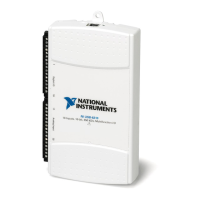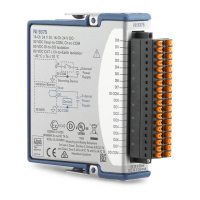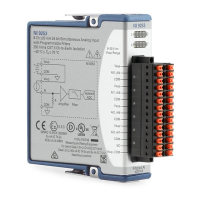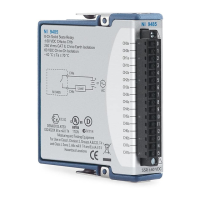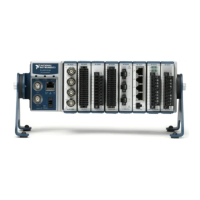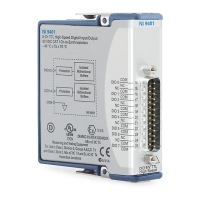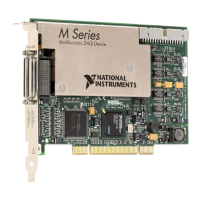© National Instruments Corporation 13 NI USB-6008/6009 User Guide and Specifications
• The signal leads travel through noisy environments.
• Two analog input channels, AI+ and AI–, are available for the signal.
DIFF signal connections reduce noise pickup and increase common-mode noise rejection. DIFF signal
connections also allow input signals to float within the working voltage of the device.
Refer to the Taking Differential Measurements section for more information about differential
connections.
When to Use Referenced Single-Ended (RSE) Connections with Floating Signal Sources
Only use RSE input connections if the input signal meets all of the following conditions:
• The input signal can share a common reference point, GND, with other signals that use RSE.
• Your application permits the use of the ±10 V input range.
• The leads connecting the signal to the device are less than 3 m (10 ft).
DIFF input connections are recommended for greater signal integrity for any input signal that does not
meet the preceding conditions.
In the single-ended modes, more electrostatic and magnetic noise couples into the signal connections
than in DIFF configurations. The coupling is the result of differences in the signal path. Magnetic
coupling is proportional to the area between the two signal conductors. Electrical coupling is a function
of how much the electric field differs between the two conductors.
With this type of connection, the PGA rejects both the common-mode noise in the signal and the ground
potential difference between the signal source and the device ground.
Refer to the Taking Referenced Single-Ended Measurements section for more information about RSE
connections.
Ground-Referenced Signal Sources
A ground-referenced signal source is a signal source connected to the building system ground. It is
already connected to a common ground point with respect to the device, assuming that the computer is
plugged into the same power system as the source. Non-isolated outputs of instruments and devices that
plug into the building power system fall into this category.
The difference in ground potential between two instruments connected to the same building power
system is typically between 1 and 100 mV, but the difference can be much higher if power distribution
circuits are improperly connected. If a grounded signal source is incorrectly measured, this difference
can appear as measurement error. Follow the connection instructions for grounded signal sources to
eliminate this ground potential difference from the measured signal.
Refer to the NI Developer Zone document, Field Wiring and Noise Considerations for Analog Signals,
for more information. To access this document, go to ni.com/info and enter the Info Code rdfwn3.
When to Use Differential Connections with Ground-Referenced Signal Sources
Use DIFF input connections for any channel that meets any of the following conditions:
• Your application requires input ranges other than ±10 V.
• The input signal is low level and requires greater accuracy.
• The leads connecting the signal to the device are greater than 3 m (10 ft).
• The input signal requires a separate ground-reference point or return signal.
• The signal leads travel through noisy environments.
• Two analog input channels, AI+ and AI–, are available for the signal.
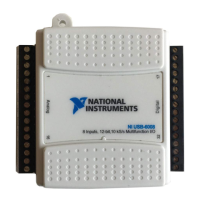
